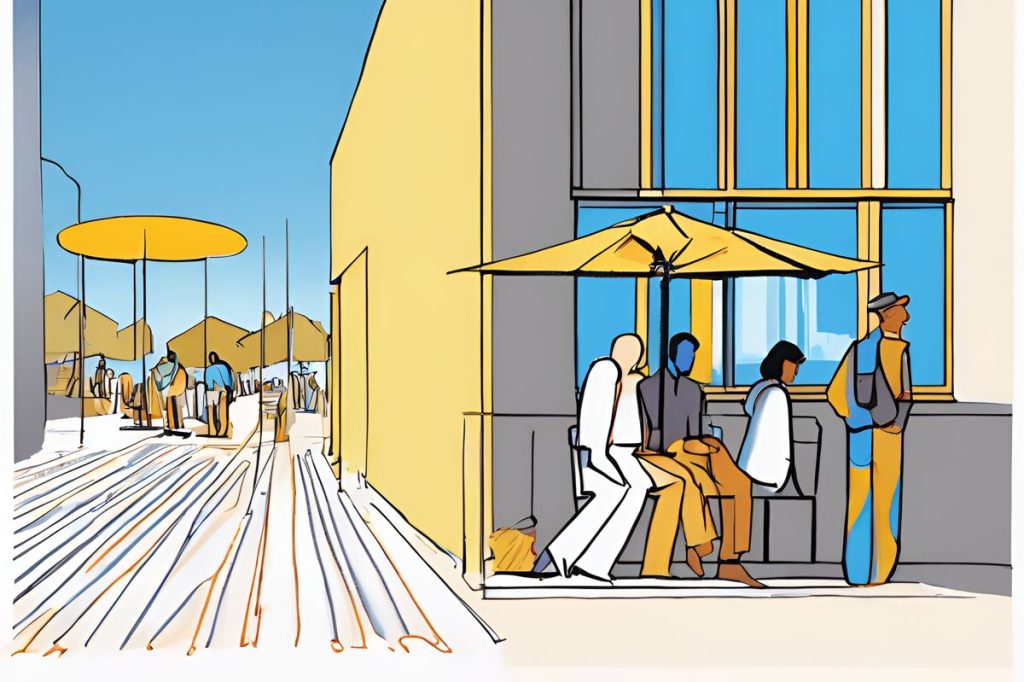Nicosia is tackling its scorching summer heat by boosting tree coverage and implementing various initiatives, such as portable shades, indoor vegetation, and communal cooling centers. With only four percent of its area shaded by trees, the city’s move towards a greener future aims to combat the urban heat island effect and create a more habitable environment for its residents.
What measures is Nicosia taking to combat summer heat?
Nicosia is combating summer heat by planning to increase tree coverage, which reduces air pollution and the urban heat island effect. Initiatives include awareness campaigns on staying hydrated and avoiding sun, portable shades, indoor vegetation, communal cooling centers, and encouraging community tree planting. Urban planning also incorporates green roofs and vertical gardens.
The Climate Quandary in Cyprus’ Capital
Nicosia, the heart of Cyprus and its bustling capital, is on the verge of yet another sweltering summer. Erdogan Bekiroglu, a technical advisor to the Nicosia Turkish Municipality, has issued a rather stark warning to the city’s inhabitants. With temperatures expected to soar, he advises residents to make their summer getaway plans “as far as possible” from Nicosia. His concerns are not unfounded; the city suffers from an acute shortage of natural canopies, with a mere four percent of its area sheltered by trees—alarmingly, the lowest in all of Europe as per data from the European Environment Agency.
The scorching heat poses not just discomfort but a significant health risk, particularly to the vulnerable populations. Nicosia’s urban planning, however, is taking a turn towards the green. Projects are in the pipeline aiming to bolster the city’s resilience against the heat. These initiatives, once in place, promise to make Nicosia a more habitable environment even when the mercury climbs.
Nicosia’s Urban Forest: A Fledgling Vision
The stark lack of greenery isn’t just a question of aesthetics; it has tangible impacts on the quality of life for those on either side of the city. Urban trees do more than just provide shade; they are vital for reducing air pollution, mitigating the urban heat island effect, and enhancing biodiversity. In Nicosia, where the summers are especially unforgiving, tree canopies could be the frontline warriors against the intensifying heat waves, offering a natural respite to the city’s residents and visitors alike.
Recognizing the urgency, the Nicosia Turkish Municipality has hinted at a greener future with projects aimed at increasing tree coverage in the capital. Though details of these schemes are not yet fully public, they are a beacon of hope for a cooler, more sustainable Nicosia. The planned work suggests a move towards a more proactive urban design, one that acknowledges the importance of green infrastructure in city planning.
Preemptive Measures and Public Awareness
While the municipality gears up to tackle the challenge head-on, it is crucial for the public to stay informed and prepared. Awareness campaigns emphasizing the importance of staying hydrated, avoiding the midday sun, and recognizing heatstroke symptoms could make a significant difference. Until the shade-boosting projects come to fruition, residents might need to rely on temporary solutions such as portable shades, increased indoor vegetation, and communal cooling centers to beat the heat.
Moreover, community involvement in tree planting initiatives could foster a sense of ownership and responsibility towards the city’s environmental well-being. Encouraging citizens to plant and care for trees not only aids the municipality’s efforts but also instills a green conscience within the community—something that will benefit Nicosia well beyond the summer months.
Urban Planning for Future Summers
The situation in Nicosia serves as a case study in the importance of urban planning that takes climate change into consideration. With the city’s tree coverage lagging behind, the local government’s response will be pivotal in shaping how the capital withstands future temperature extremes. The introduction of green roofs, vertical gardens, and the expansion of urban parks could be part of a broader strategy to cool the cityscape.
As climate patterns continue to evolve, cities worldwide will be watching and learning from Nicosia’s approach to combating heat. It’s a reminder that as the global community confronts the realities of climate change, adaptation and resilience must be woven into the very fabric of our urban environments.
What measures is Nicosia taking to combat summer heat?
Nicosia is combating summer heat by planning to increase tree coverage, which reduces air pollution and the urban heat island effect. Initiatives include awareness campaigns on staying hydrated and avoiding sun, portable shades, indoor vegetation, communal cooling centers, and encouraging community tree planting. Urban planning also incorporates green roofs and vertical gardens.
Why is Nicosia focusing on increasing tree coverage?
Nicosia is focusing on increasing tree coverage to combat the urban heat island effect, reduce air pollution, and create a more habitable environment for its residents. Trees provide shade, cool the surrounding area, and improve air quality, making them essential in mitigating the impact of the scorching summer heat.
How is the community getting involved in Nicosia’s efforts to combat summer heat?
The community in Nicosia is getting involved in combating summer heat by participating in tree planting initiatives. By planting and caring for trees, residents are contributing to the city’s efforts to boost tree coverage. Additionally, public awareness campaigns are encouraging residents to stay hydrated, avoid the midday sun, and recognize heatstroke symptoms to stay safe during hot weather.
What role does urban planning play in Nicosia’s strategy for combating summer heat?
Urban planning plays a crucial role in Nicosia’s strategy for combating summer heat by incorporating green infrastructure such as green roofs, vertical gardens, and urban parks. These elements help cool the cityscape, reduce the urban heat island effect, and create a more sustainable and resilient urban environment for the residents of Nicosia.

